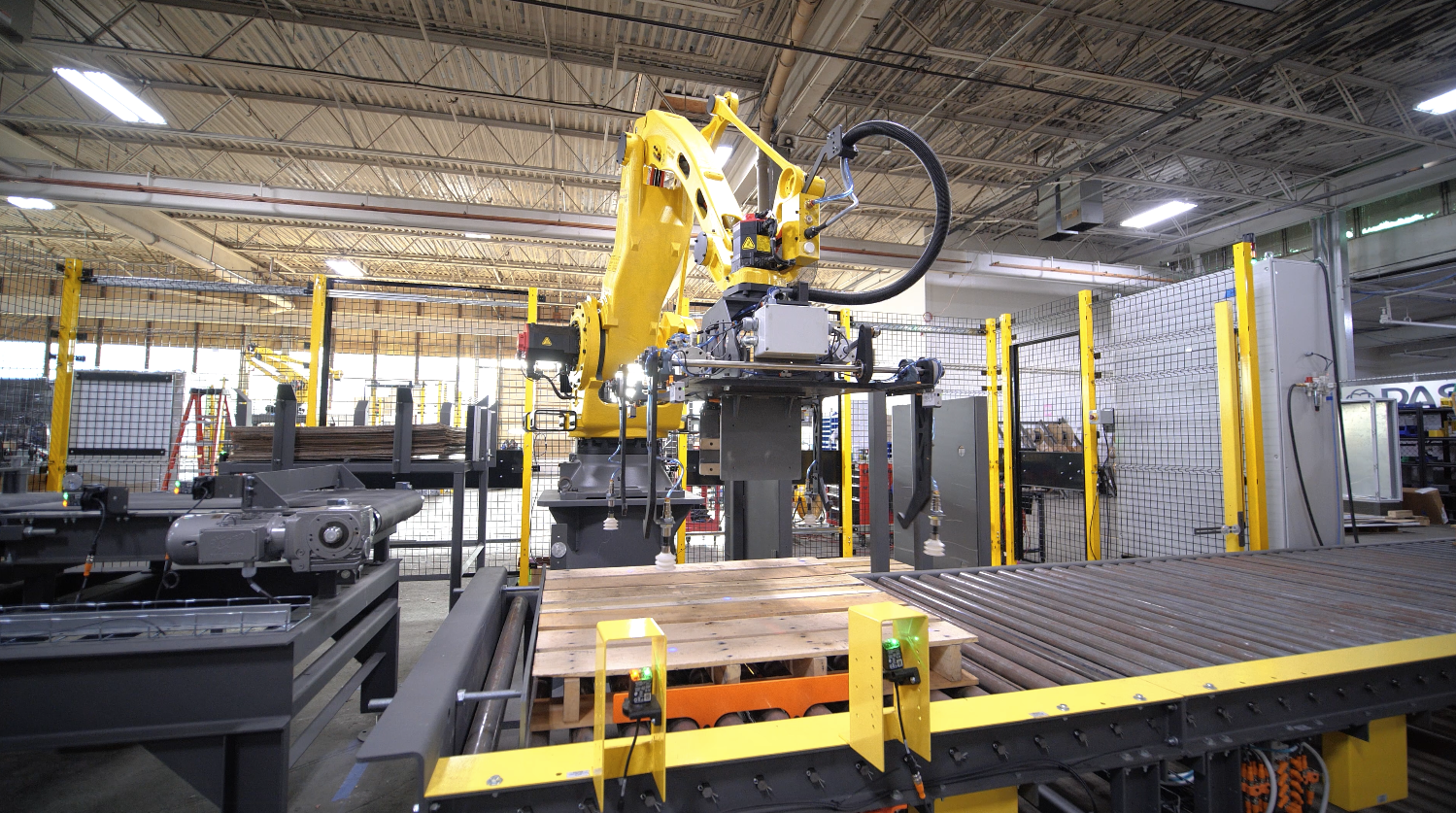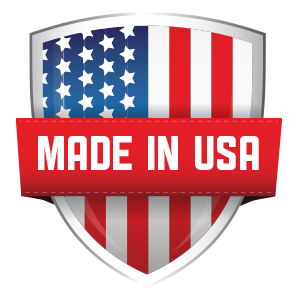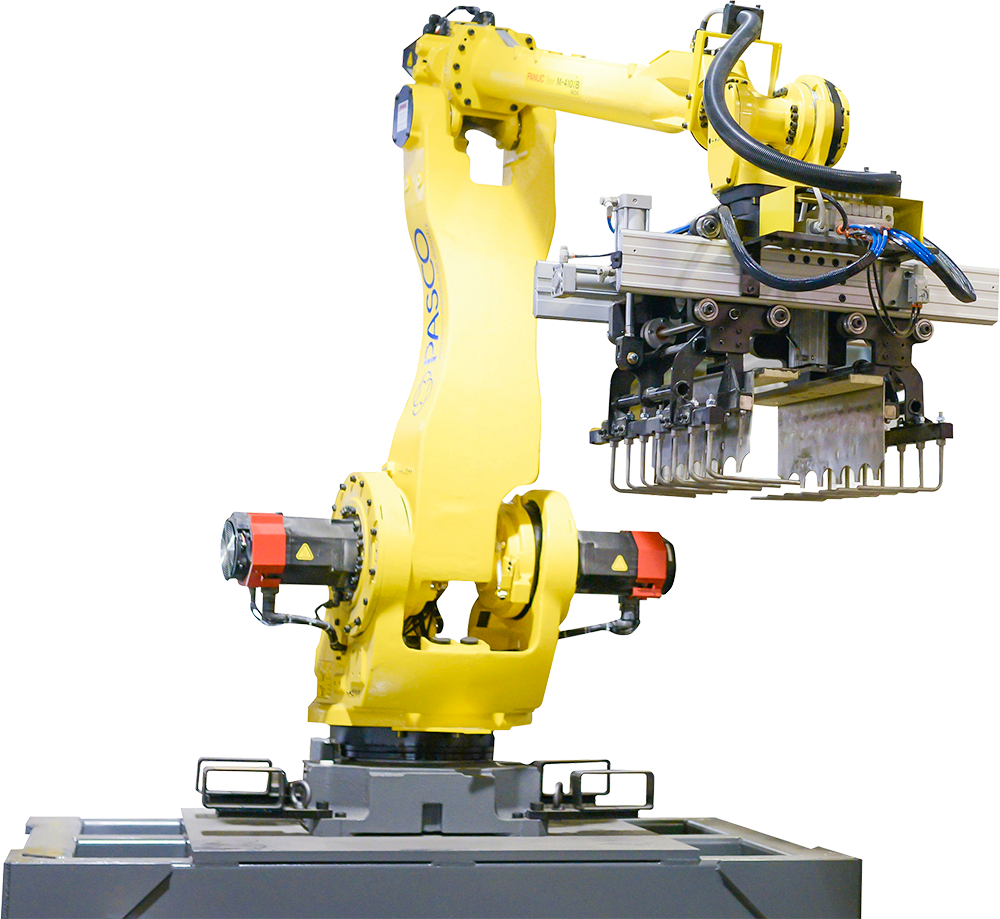Automating palletizing for a new U.S. production line
A building products manufacturer was launching a new U.S. facility to support rising demand for its finishing compound product. At the start of the quoting process, the product was still being shipped from overseas but market demand had justified a full domestic line. They needed a robotic palletizing system that could support startup production while remaining flexible enough to scale with any future growth for their new facility.
The challenge: Palletize bundles from a multi-OEM line
The line included equipment from multiple OEMs: a filler and bundler upstream and a stretch hooder downstream. They needed to palletize the bundles being generated upstream. To do that, they needed to place a pallet, place a slip sheet and start stacking loads on those pallets.
The standard approach would be three separate pieces of equipment to handle each function: a pallet dispenser, a slip sheet dispenser and a robotic palletizing cell. That increases footprint, cost and maintenance overhead.
We took a different path: what if the robot could do all three?
The PASCO approach: Design around the robot
What made this different wasn’t just the tooling alone, it was how we approached the problem.
We look at the rate, the space and what the robot can realistically handle. Then we ask what’s actually necessary. In this case, once we assessed the rates they needed to meet and the capability of the robot itself, we realized the robot had the bandwidth to do more than just palletize. So we designed the tooling to let it handle multiple functions.
We build systems this way on purpose. Not over-complicated. Not overbuilt. Clean, efficient, and designed to scale with the customer, not fight them later.
The solution: One robot, three functions
The custom end-of-arm tool allowed the robot to:
- Pick and place empty pallets
- Pick and place slip sheets
- Stack bundled product efficiently and effectively
The end-of-arm tool was designed in-house to handle all three functions. That decision removed two major subsystems entirely, which made the cell smaller in size, easier to maintain and more cost effective for the customer. The robot stayed active throughout each cycle, doing more with every move.
By consolidating those functions into a single tool, the robot became the core material handler of the system, reducing the overall component count. That translates directly to lower capital cost, fewer failure points and shorter install time.
Why slower rates were a design advantage
The customer’s initial required production rate was relatively modest, which made this multifunctional tooling strategy a perfect fit. Because the robot wasn’t under time pressure, it could perform all three tasks without compromising cycle time. This gave us the freedom to design for function, not just speed.
And like every system we build, it wasn’t just designed for startup. The robot, EOAT and cell were all sized to support higher speeds and future throughput with no redesign needed.
Seamless integration across OEM boundaries
The bundle palletizer was designed to install between upstream and downstream equipment from different providers. Thanks to a clean plant layout provided early in the project, we were able to dimension the system precisely and align every handoff point — pallet entry, bundle pickup, final stack discharge — with surrounding systems.
Even when working with multiple OEMs, the integration held up because everything on our side was engineered for clarity and fit.
Built for practical efficiency
We focused on where automation would create the most value, not the most complexity. The result is a robotic palletizing system that:
- Handles three functions with one robot
- Has fewer moving parts and simpler maintenance
- Fits tight footprints in new facilities
- Integrates cleanly with third-party equipment
- Leaves headroom to scale with production growth
Results at a glance
- Multifunctional EOAT: One tool handles pallets, slip sheets, and product
- Lower total cost of ownership: Fewer devices, fewer maintenance points
- Robot-driven efficiency: Smarter tooling with fewer wasted movements
- Tight integration: Aligned precisely with upstream and downstream systems
- Scalable design: Ready to support future throughput increases
Ready to optimize your palletizing process?
Looking for a robotic palletizer that works harder without costing more? Let’s talk about how smart tooling and efficient design can deliver more from day one and keep delivering as your line evolves.



